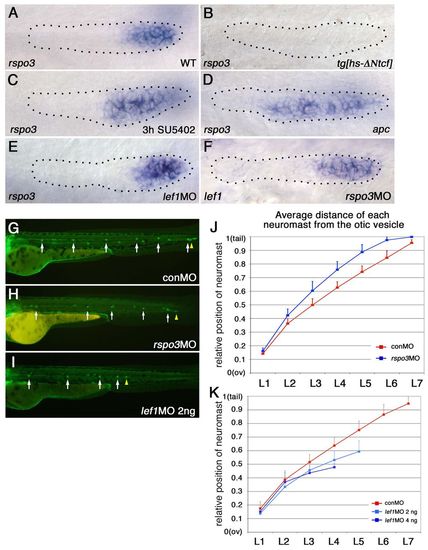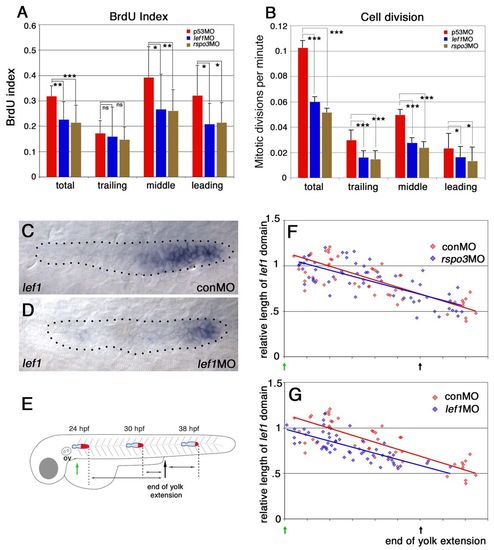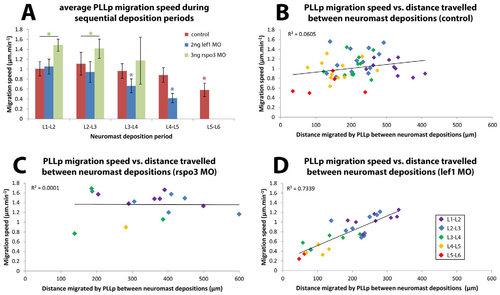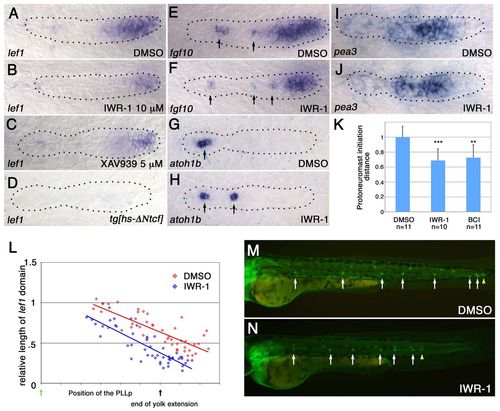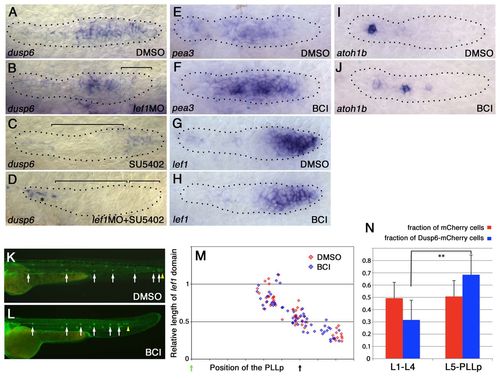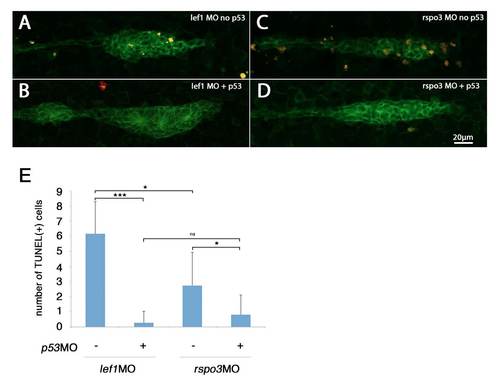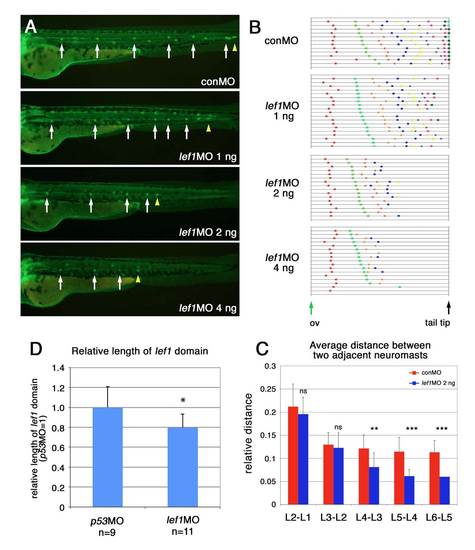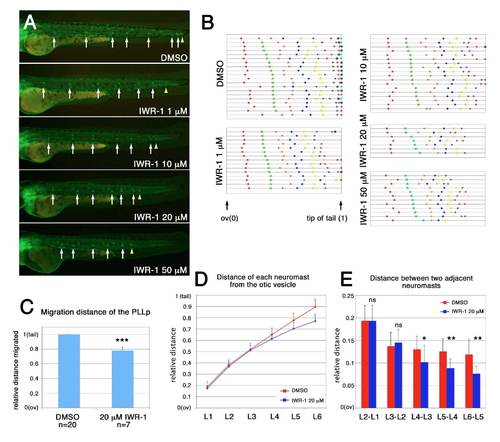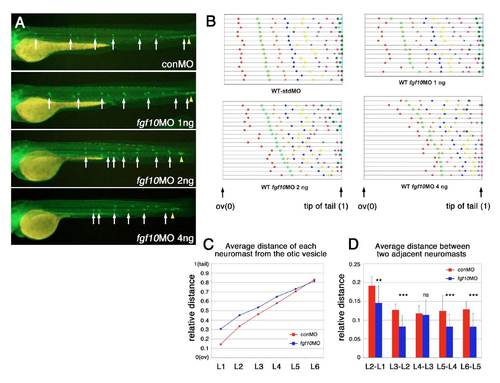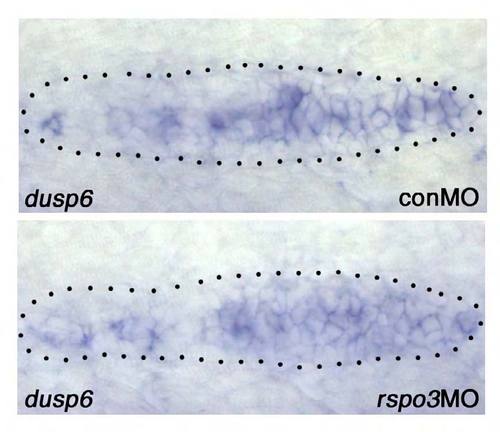- Title
-
Lef1 regulates Dusp6 to influence neuromast formation and spacing in the zebrafish posterior lateral line primordium
- Authors
- Matsuda, M., Nogare, D.D., Somers, K., Martin, K., Wang, C., and Chitnis, A.B.
- Source
- Full text @ Development
|
Expression of rspo3 and lef1 is determined by similar mechanisms but knockdown of rspo3 and of lef1 have distinct effects on the pattern of neuromast deposition. (A-I) The leading end of the PLLp and caudal end of the zebrafish embryo are to the right. (A-F) The PLLp is outlined (dotted line). (A-D) Expression of rspo3 in the PLLp at 31 hpf. (A) rspo3 is expressed in the leading domain of the wild-type (WT) PLLp. (B) Heat shock-induced expression of a dominant-repressor form of TCF (ΔNTcf) inhibits rspo3 expression. (C,D) Exaggeration of Wnt activity, following inhibition of FGFR signaling with SU5402 (C) or in apc mutants (D), expands rspo3 expression toward the trailing domain. (E,F) rspo3 expression in the lef1 morphant PLLp (E) and lef1 expression in the rspo3 morphant PLLp (F) at 31 hpf. (G-K) The pattern of neuromast deposition in lef1 morphants and rspo3 morphants. (G-I) Neuromast deposition in tg[cldnb:lynGFP] embryos injected with lef1-MO, rspo3-MO or control-MO (conMO) at 48 hpf. White arrows indicate individual neuromasts and yellow arrowheads indicate PLLp termination. (J,K) Average position of each deposited neuromast in lef1 or rspo3 morphants relative to the distance from the otic vesicle (ov) to the tip of the tail. (H,J) Neuromasts are spaced further apart in rspo3 morphants. See supplementary material Fig. S4 for suppression of this phenotype by rspo3 mRNA co-injection. (I,K) Neuromasts are spaced closer together in lef1 morphants. Error bars indicate s.d. |
|
Although rspo3 and lef1 morphants have similar changes in cell proliferation, the size of the lef1 expression domain is only reduced in lef1 morphants. (A,B) Knockdown of lef1 and of rspo3 reduce proliferation in a similar manner. (A) Total and regional BrdU incorporation index in the PLLp of control, lef1 morphant and rspo3 morphant embryos (see also supplementary material Table S1). (B) Total and regional cell division in the PLLp of control, lef1 morphant and rspo3 morphant embryos. ns, non-significant (P>0.05); *P<0.05, **P<0.01, ***P<0.001 (see also supplementary material Table S2). Error bars indicate s.d. (C,D) The lef1 expression domain is smaller in lef1 morphants at 31 hpf. For statistical analysis, see supplementary material Fig. S5D. (E) The progressive change in the size of the lef1 domain (red) over the course of PLLp migration. (F,G) Size of the lef1 domain (relative to its average length in control embryos at 24 hpf) plotted against the position of the PLLp along the trunk for a collection of embryos fixed between 24 and 38 hpf (see schematic in E). Red dots indicate control-MO-injected embryos and blue dots indicate either rspo3 (F) or lef1 (G) morphant embryos. Red or blue lines indicate the associated linear regression lines for each data set. A simple linear regression model and a paired t-test confirmed that the length of the lef1 domain is significantly reduced in lef1 morphants (P<0.001). |
|
Correlation of PLLp migration speed with spacing of deposited neuromasts. (A) PLLp migration speed compared in control, lef1 and rspo3 morphant embryos in successive periods between neuromast deposition. Red asterisk indicates that the speed between L5-L6 depositions was significantly slower than between preceding L4-L5 depositions. Blue asterisks indicate that PLLp speed in lef1 morphants between L3-L4 and L4-L5 depositions was significantly slower than in the respective, preceding deposition cycles. In addition, PLLp speed in lef1 morphants between L3-L4 and L4-L5 depositions was significantly slower than in controls during the same deposition cycle. Green asterisks indicate statistical significance between the indicated measurements (black bar). *P<0.05. Error bars indicate s.d. (B-D) PLLp migration speed plotted against distance traveled between neuromast depositions in wild-type (B), rspo3 morphant (C) and lef1 morphant (D) embryos. Points are shown in different colors for successive pairs of neuromasts (color key in D). Linear regression lines are shown for each data set. The associated coefficient of determination (R2) indicates that the correlation between PLLp migration speed and distance traveled between neuromast depositions is strong only for lef1 morphants. See Table S3 for additional information. |
|
Weakening Wnt signaling facilitates proto-neuromast maturation and deposition. (A-D) Wnt inhibitors reduce lef1 expression. lef1 expression is shown in the PLLp following exposure to DMSO control (A), IWR-1 (B) and XAV939 (C), and following heat shock-induced expression of ΔNTcf (D) at 31 hpf. (E,F) IWR-1 shrinks the broad leading fgf10 expression domain while exposing more spots of trailing fgf10 expression (arrows). (G,H) Premature appearance of atoh1b expression (arrows) in IWR-1-treated PLLp at ~31 hpf. (I,J) pea3 expression is not obviously altered in IWR-1-treated embryos. (K) Proto-neuromast formation is initiated closer to the leading edge in IWR-1-treated and BCI-treated embryos. **P<0.01, ***P<0.001. Error bars indicate s.d. (L) Comparison of the relative size of the lef1 expression domain at different stages of migration in embryos treated with DMSO (red) or 10 μM IWR-1 (blue), as in Fig. 2F,G. A simple linear regression model and a paired t-test confirmed that the length of the lef1 domain is significantly smaller in the IWR-1-treated embryos. P<0.0001. (M,N) Neuromast deposition in embryos treated with DMSO (M) or IWR-1 (N). |
|
Knockdown of fgf10 delays initial neuromast formation and deposition. (A-H) Knockdown of fgf10 delays the initial restriction of the lef1 domain, the establishment of FGFR signaling and the formation of proto-neuromasts. lef1 (A,B), pea3 (C,D), and atoh1a (E,F) expression is shown in control (conMO) and fgf10 morphant embryos at 31 hpf. For statistical analysis, see supplementary material Fig. S8. (G,H) Epithelial rosette formation visualized by central accumulation (arrows) of ZO-1 (green) and Cldnb (red). (I-P) By 35 hpf, however, there is restriction of lef1 (I,J), recovery of pea3 (K,L) and establishment of multiple proto-neuromasts, as shown by focal atoh1a (M,N) and central accumulation of ZO-1 (green) and Cldnb (red) (O,P). (Q,R) Deposition of the first neuromast is delayed in fgf10 morphants and subsequent neuromasts are deposited at closer intervals. (S) Dose-dependent delay in L1 neuromast deposition. *P<0.05, ***P<0.001. Error bars indicate s.d. (T) Comparison of the relative size of the lef1 expression domain at different stages of migration in control (red) and fgf10 morphant (blue) embryos, as in Fig. 2E. |
|
Attenuation of Wnt signaling facilitates neuromast formation in fgf10 morphants. (A-L) Attenuation of Wnt signaling with IWR-1 facilitates earlier shrinking of the Wnt system, earlier establishment of effective FGFR signaling and earlier initiation of neuromast deposition in the PLLp of fgf10 morphants. lef1 expression (A-D), pea3 expression (E-H) and the neuromast deposition pattern (I-L, arrows) are shown in control morphants (A,E,I), control morphants with IWR-1 treatment (B,F,J), fgf10 morphants (C,G,K) and fgf10 morphants with IWR-1 treatment (D,H,L). For statistical analysis, see |
|
Lef1 determines leading dusp6 expression and inhibition of Lef1 function influences the pattern of proto-neuromast formation and neuromast deposition. (A-D) dusp6 expression is regulated by Lef1 and FGFR signaling. (A) dusp6 is expressed in the leading two-thirds of the PLLp. (B) lef1 knockdown eliminates dusp6 expression in a leading domain. (C) SU5402 treatment eliminates trailing dusp6 expression. (D) SU5402 treatment in lef1 morphants eliminates dusp6 expression in the PLLp. Bracket shows where dusp6 expression is lost. Asterisk indicates persistent dusp6 expression in prospective inter-neuromast cells. (E,F) pea3 expression shows that FGFR signaling is enhanced in BCI-treated embryos. For statistical analysis, see supplementary material Fig. S15B. (G,H) lef1 expression suggests that Wnt signaling is not obviously altered in BCI-treated embryos. For statistical analysis, see supplementary material Fig. S15A. (I,J) atoh1b expression is seen in more proto-neuromasts closer to the lead edge of the PLLp. For statistical analysis, see supplementary material Fig. S6E. (K,L) Neuromasts are deposited closer together in BCI-treated embryos. For statistical analysis, see supplementary material Fig. S16. (M) There is no apparent difference between DMSO-treated controls and BCI-treated embryos in the size of the lef1 domain over the course of PLLp migration. (N) mCherry or Dusp6-mCherry expression was induced by heat shock treatment during PLLp migration. After the PLLp had completed migration, the numbers of red fluorescent cells were counted in each neuromast (see supplementary material Fig. S17). Cells expressing Dusp6-mCherry were less likely to be deposited in neuromasts L1-4 and more likely to be deposited in L5-6 or terminal neuromasts of the PLLp. **P<0.01. Error bars indicate s.d. |
|
Suppression of Wnt activity by rspo3 knockdown. (A-C) Expression of GFP protein in the Wnt reporter line tg(7xTCFXla. Siam:GFP)ia4 in conMO (A), rspo3-MO (B) and lef1-MO (C) morphants. Knockdown of rspo3 reduces GFP expression (B). Knockdown of lef1 inhibits GFP expression (C). (D,E) Quantification of GFP signal intensity using the photon-counting mode on a Leica hybrid detector (D), and photon counts per square micron for the GFP-positive portion of the PLLp (E). *P<0.05, **P<0.01. EXPRESSION / LABELING:
|
|
Knockdown of p53 minimizes cell death in rspo3 morphants. (A-D) TUNEL staining in lef1 morphants without p53-MO co-injection (A, n=6), lef1 morphants with p53-MO co-injection (B, n=7), rspo3 morphants without p53-MO co-injection (C, n=8) and rspo3 morphants with p53-MO co-injection (D, n=10). (E) Statistical analysis. *P<0.05, ***P<0.001; ns, not significant. |
|
Dose-dependent effects of lef1 knockdown on the pattern of neuromast deposition and PLLp termination. (A) Patterns of neuromast deposition at 48 hpf in embryos injected with 1, 2, 4 ng of lef1-MO. White arrows indicate deposited neuromasts and yellow arrowheads indicate the end of the PLLp migration. (B) Patterns of neuromast deposition in individual embryos injected with control-MO or 1, 2, 4 ng of lef1-MO. Individual embryos are represented on separate lines in an order determined by the relative position of L2. (C) Distance of two adjacent neuromasts deposited in embryos injected with control-MO (red) or 2 ng lef1-MO (blue). Data are presented as the average ± s.d. Statistical significance of the differences between each pair of groups was determined by Student’s t-test. **P<0.01, ***P<0.001; ns, not significant. (D) Effect of lef1-MO on the relative length of the leading lef1 domain at 31 hpf. Data are presented as the average ± s.d. Statistical significance of the differences between each pair of groups was determined by Student’s t-test. *P<0.05. |
|
Statistical analysis of changes in PLLp migration following different manipulations. (A) Patterns of neuromast deposition at 48 hpf in embryos treated with different doses of IWR-1. White arrows indicate deposited neuromasts and yellow arrowheads indicate the end of the PLLp migration. (B) Patterns of neuromast deposition in individual embryos. Individual embryos are represented on separate lines in an order determined by the relative position of L2. (C) Migration distance of the PLLp in DMSO and IWR-1 treated embryos at 48 hpf. Data are presented as the average ± s.d. ***P<0.001. (D) Average position of each deposited neuromast in embryos treated with DMSO or IWR-1. x-axis represents deposited neuromasts, L1 to L6, and y-axis represents distance of each deposited neuromast relative to the distance from the otic vesicle to the tip of the tail. (E) Distance between two adjacent neuromasts deposited in embryos treated with DMSO or 20 μM IWR-1. Data are presented as the average ± s.d. Statistical significance of the differences between each pair of groups was determined by Student’s t-test. *P<0.05, **P<0.01, ***P<0.001; ns, not significant. |
|
Delays in proto-neuromast formation and deposition upon fgf10 knockdown. (A) Patterns of proto-neuromast deposition at 48 hpf in embryos injected with 1, 2, 4 ng of fgf10-MO. White arrows indicate deposited neuromasts and yellow arrowheads indicate the end of the PLLp migration. (B) Patterns of neuromast deposition in individual embryos. Individual embryos are represented on separate lines in an order determined by the relative position of L2. (C) Average position of each deposited neuromast in embryos injected with 2 ng fgf10-MO. x-axis represents deposited neuromasts, L1 to L6, and y-axis represents distance of each deposited neuromast relative to the distance from the otic vesicle to the tip of the tail. (D) Distance of two adjacent proto-neuromasts deposited in embryos injected with 2 ng fgf10-MO. Data are presented as the average ± s.d. Statistical significance of the differences between each pair of groups was determined by Student’s t-test. **P<0.01, ***P<0.001; ns, not significant. |
|
Knockdown of rspo3 does not alter dusp6 expression. dusp6 expression in conMO PLLp and rspo3-MO PLLp at 31 hpf. Knockdown of rspo3 does not alter the pattern of dusp6 expression. |

